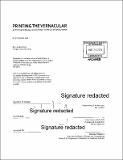Printing the vernacular : 3D printing technology and its impact on the City of Sana'a, Yemen
Author(s)
Kim, Kyungsik, M. Arch. Massachusetts Institute of Technology
DownloadFull printable version (27.65Mb)
Alternative title
3D printing technology and its impact on the City of Sana'a, Yemen
Other Contributors
Massachusetts Institute of Technology. Department of Architecture.
Advisor
Antón García-Abril.
Terms of use
Metadata
Show full item recordAbstract
This thesis project is a speculative proposal; it assumes that 3D printing technology is a major manufacturing and construction method in the future. The industrial revolution that has begun in the 19th century was the transition to a new manufacturing process. This transition included going from hand production to machine production and eventually changed the entire way of making things, buying things, moving things, and etc. The changes of our life led to the transformation of our cities. Current cities were formed based on the Industrial Supply Chain that enables flow of materials and products from supplier to customer. This supply chain decided locations of factories, retails, roads, ports, warehouses, and etc that have structured cities. In recent years, 3D printing has attracted increasing attention. The prospect of printing machines has inspired enthusiasts to proclaim that 3D printing will bring "the next industrial revolution", while others have reacted with skepticism and point to the technology's current limitations. However, 3D printing could proliferate rapidly over the coming decade. Improvements in speed and performance could enable unprecedented levels of mass customization, simplified supply chains, and even the "democratization" of manufacturing as consumers begin to print their own products. Although there has been a number of studies on the 3D Printing technology itself and its impact on economy, less attentions have been paid to its spatial impact or impact on our cities. As the industrial revolution transformed cities, 3D Printing is expected to change our current cities in many ways, as it will change the way of making, moving, buying things again. The fact that 3D Printing can be done near the point of consumption, implies several possible scenarios of future cities This thesis illustrates different degrees of influence of the technology in the city of Sana'a, Yemen. The city has four distinct areas currently: the historical world heritage site, a partially protected area, a modernized area, and an informal settlement. The four distinct areas will be changed in different ways by different uses of 3D printing technology. The tower house, which is one of the most significant building typologies of the city, is used to examine and compare the influences of the technology. More specifically, the ornament of the tower house and possible scenarios of transformation are the main design focus of the project. Ornament will appear in different scales and configurations in the future city of Sana'a, from high resolution ornament to inhabitable ornament.
Description
Thesis: M. Arch., Massachusetts Institute of Technology, Department of Architecture, 2016. Cataloged from PDF version of thesis. Includes bibliographical references (page 121).
Date issued
2016Department
Massachusetts Institute of Technology. Department of ArchitecturePublisher
Massachusetts Institute of Technology
Keywords
Architecture.